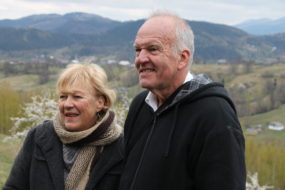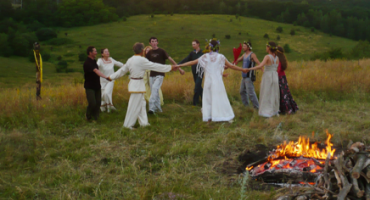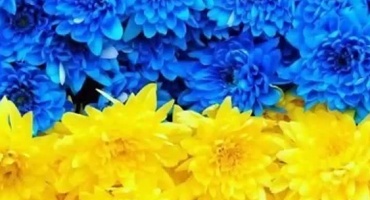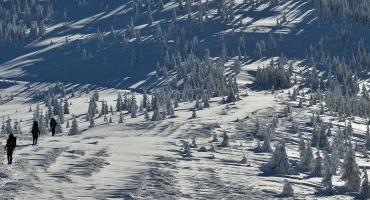UKRAINIAN HERITAGE: A STORY OF ANNA KATERYNIUK
2018-12-03 17:17:52
We’re starting to share the stories of Ukrainians from all over the world. And the first story is from our Australian guests - Jean and John. It's about their mother - Ukrainian Anna Kateryniuk who emigrated from Otyniya to Australia. We're happy that Anna's children are interested in the country of their mother's origin. Once in few years, they come to Ukraine to visit the place of their parents' birth, get to more about traditions that mom was telling them about and, of course, travel.

We publish a story in parts, however, save the original words from the author.
My name is Anna Kateryniuk. Born on 17th December, 1922, in a small town called Otyniya, in Ukraine. I had four brothers, Dmitro, Mykola, Vasyl and Fedir. I also had a sister, Mariya, who died at birth. We were an impoverished family. We had little clothing or shoes, poor diet, no medical facilities and winters were very harsh and cold.
We initially lived in a small, rented house in Otyniya. When I turned three, my mother moved in with her mother on a half-acre property in Molodyliv, some miles out of Otyniya. My mother earned money by washing and cleaning for other people plus working in the fields. My father worked in town as a carpenter and visited us when he could.
All the family, including her brothers and Anna herself, had to work hard to make a living and be able to have what to eat and what to wear. Nevertheless, Anna, being a child, still managed to mess, fool around and do some tricks as every child do.
Of my siblings, I was the boldest. ‘Trouble’ was my middle name.
Anna shared the stories about how she marked each brick with dog-like imprints on the bricks factory nearby while they were left to dry outside, how she destroyed her brand new red dress that her mom was hard to buy, how she loved dolls and cut up the new grandma’s skirt and ribbons for dolls clothes.
Dolls played an important role in my childhood. My mother eventually bought me a plastic doll. My excitement was short-lived. A few days later, as my mother was feeding the pigs, I was holding the candle for her. Suddenly, the doll got too close to the candle and burst into flames. That’s how I lost my first doll.
In 1931 Stalin commenced his Holodomor or genocide of the Ukrainian people by starvation. From 1932 to 1933 seven million Ukrainians starved to death. At this time their family was very poor and there was not enough food to feed them all. To take some of the burdens of her mother, Anna was sent away to work for another family at the age of 9.
I was always hungry and never had enough sleep. The old lady didn’t realize that a growing child needed lots of good food.
She spent 4 years in a hard labor when finally and happily after escaped back home.
I spent the next year at home, during which time I worked as a housemaid for a school teacher. After the school teacher left, I unsuccessfully tried to find field work at the nearby farms to earn enough money for food. At the age of 15 I found a job in town in a small hotel, cleaning and when necessary, serving behind the counter.
She stayed working there until the year 1941. That’s when the war began.
Early one summer morning in 1941 there was a knock at the door. It was the Russian boss. He yelled, “Get up Anna! The milking girls are already in the stables and you’re still in bed!” I had no idea of the time. When I got to the stables, the boss wanted to talk to us. He said the Germans are coming and all the young people had to flee. I asked about my mother. “I can’t just leave her.” But the older people had to stay and face an uncertain future. We were to take the cows across miles of unfamiliar country. At about 3.00 pm we rounded up most of the cows and with the boss, we started on our journey.
We walked about 3 miles to the village of our Director. On arrival, we were told that our Director had fled but without him, it was useless for us to continue. We were told that the Germans were approaching and the Russians had left. We could hear shooting in the distance.
During the winter of 1942, there was an extreme food shortage in the Ukraine. This period also corresponded to an extreme labor shortage in Germany. To overcome the shortage, the Germans implemented a policy of transporting the young and healthy to Germany as forced labor. Many initially volunteered to escape the Soviet tyranny and food shortages. They were promised hot food & good working conditions. When the Ostarbeiter (OST or Eastern Workers) discovered conditions were also harsh in Germany, voluntary transfers halted and the Germans soldiers commenced rounding up able-bodied persons off the street, from their homes or from churches. Some people tried to hide but were always found. If a woman left her child at home and went to church, she would be forced to go with the soldiers and never see her child again. These people were transported to Germany to work in German factories and farms.

The last time I saw my mother was 2nd January 1942 when we were taken to the train station at Kolomyia and packed into cattle carriages. There was no room to sit or lie down. We were barely able to move. The journey took 2 sleepless days and nights, during which time we were fed only once.
After reaching out the destination people were distributed to different parts of Germany for forced work. So was Anna.
On arrival a very large woman of about 50 came out and asked us questions. She indicated that she wanted to know our ages. I was 20 and my friend was 40. She chose me and took me upstairs and showed me to my room. I told her my name was Anna Kateryniuk and she started calling me Katarina. “No, it’s Anna.” So Katarina it was.
There she’s working on the farm together with other workers, among which were also two Polish soldiers.
As the Polish soldiers could understand German and I understood Polish, the language barrier between Emma and myself was eventually resolved.
In two months I learned more German than the Polish soldiers learned in a year. I was pleased that Emma (German woman she worked for) and I could converse.
However, the life in Germany was not cheerful at all. It was full of uncertainty as we were in constant danger of being bombed

During Anna's stay here she met Yosep Oryszczak, who worked for a coal delivery service nearby. At the end of the war, they were moved to a camp in Dusseldorf. From there the Allies transferred them to a camp in Wulfrath, where Yosep and Anna were married and she became Anna Oryszczak. She was 23 and Yosep 29.
After sojourning from place to place in Germany they had to decide about their future.
We had no desire to return to the Ukraine where conditions were harsh and the Russians would seek retribution for us having worked for the Germans.
The ones who were returned were often treated as traitors and sent to remote locations in the Soviet Union as forced labor. So Yosep and Anna were searching for the place to go.
In Hamburg, English officials offered us resettlement in Canada or Australia. An abundance of rabbits in Australia and the cold weather in Canada made Australia our first choice. We left Hamburg by train and arrived in Italy a day later. We remained there for three weeks before boarding a Dutch ship, the Hansleman, for Australia. We were at last heading for the land of peace. The trip took 26 days and we arrived in Sydney on 29 November 1949.

That’s where the family found its peace. By working hard they got their proper house and place to live happily after.
This home meant happiness and a secure future, free of fear and sorrow which had been missing from our lives up until then. It was our first and only real home.
They got two children, Genia and Yulik, that became known as Jean and John.

On the 16th October 1975, Joseph suffered a stroke and was no longer able to work. On 31st December 1987 and the age of 70, he suffered a massive pulmonary embolism and died in the home he loved.

Anna was now living on her own on this large property and eventually found it too difficult to cope. In April 1992 she bought a townhouse in Stephen St Blacktown, where she lived until she suffered a massive stroke and died 12th October 2004.
Travel with us
Join thousands of travelers, who explored Ukraine with our adventure, cultural or heritage tours since 2011.Trusted by National Geographic, BBCW, Wild Frontiers and others.
Ask us anything





